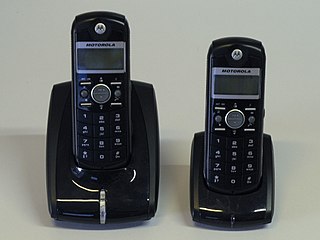The ISM radio bands are portions of the radio spectrum reserved internationally for industrial, scientific, and medical (ISM) purposes, excluding applications in telecommunications. Examples of applications for the use of radio frequency (RF) energy in these bands include RF heating, microwave ovens, and medical diathermy machines. The powerful emissions of these devices can create electromagnetic interference and disrupt radio communication using the same frequency, so these devices are limited to certain bands of frequencies. In general, communications equipment operating in ISM bands must tolerate any interference generated by ISM applications, and users have no regulatory protection from ISM device operation in these bands.

In telecommunications, direct-sequence spread spectrum (DSSS) is a spread-spectrum modulation technique primarily used to reduce overall signal interference. The direct-sequence modulation makes the transmitted signal wider in bandwidth than the information bandwidth. After the despreading or removal of the direct-sequence modulation in the receiver, the information bandwidth is restored, while the unintentional and intentional interference is substantially reduced.

Frequency-hopping spread spectrum (FHSS) is a method of transmitting radio signals by rapidly changing the carrier frequency among many frequencies occupying a large spectral band. The changes are controlled by a code known to both transmitter and receiver. FHSS is used to avoid interference, to prevent eavesdropping, and to enable code-division multiple access (CDMA) communications.

A radio-controlled model is a model that is steerable with the use of radio control (RC). All types of model vehicles have had RC systems installed in them, including ground vehicles, boats, planes, helicopters and even submarines and scale railway locomotives.

Radio control is the use of control signals transmitted by radio to remotely operate a device. Examples of simple radio control systems are garage door openers and keyless entry systems for vehicles, in which a small handheld radio transmitter unlocks or opens doors. Radio control is also used for control of model vehicles from a hand-held radio transmitter. Industrial, military, and scientific research organizations make use of radio-controlled vehicles as well. A rapidly growing application is control of unmanned aerial vehicles for both civilian and military uses, although these have more sophisticated control systems than traditional applications.
The radio spectrum is the part of the electromagnetic spectrum with frequencies from 3 Hz to 3,000 GHz (3 THz). Electromagnetic waves in this frequency range, called radio waves, are widely used in modern technology, particularly in telecommunication. To prevent interference between different users, the generation and transmission of radio waves is strictly regulated by national laws, coordinated by an international body, the International Telecommunication Union (ITU).

A cordless telephone or portable telephone has a portable telephone handset that connects by radio to a base station connected to the public telephone network. The operational range is limited, usually to the same building or within some short distance from the base station.
The 70-centimeter or 440 MHz band is a portion of the UHF radio spectrum internationally allocated to amateur radio and amateur satellite use. The ITU amateur radio allocation is from 430 to 440 MHz; however, some countries, such as the United States, allocate hams 420 to 450 MHz. Depending on the country the band is shared with other radio services.

A radio-controlled aircraft is a small flying machine that is radio controlled by an operator on the ground using a hand-held radio transmitter. The transmitter continuously communicates with a receiver within the craft that sends signals to servomechanisms (servos) which move the control surfaces based on the position of joysticks on the transmitter. The control surfaces, in turn, directly affect the orientation of the plane.

ParkZone was a brand specializing in intermediate-level, radio-controlled electric model aircraft. It was created and distributed by Horizon Hobby, an American hobby manufacturer based in Champaign, Illinois, United States. The term "park flyer" inspired the brand name, signifying compact models suitable for flying in parks.

A radio-controlled helicopter is model aircraft which is distinct from a RC airplane because of the differences in construction, aerodynamics, and flight training. Several basic designs of RC helicopters exist, of which some are more maneuverable than others. The more maneuverable designs are often harder to fly, but benefit from greater aerobatic capabilities.

Multiplex Modellsport GmbH & Co. KG of Bretten-Gölshausen, Germany is a manufacturer of hobby-grade radio control electronics, electric radio-controlled airplanes and electric helicopters.

A wireless microphone, or cordless microphone, is a microphone without a physical cable connecting it directly to the sound recording or amplifying equipment with which it is associated. Also known as a radio microphone, it has a small, battery-powered radio transmitter in the microphone body, which transmits the audio signal from the microphone by radio waves to a nearby receiver unit, which recovers the audio. The other audio equipment is connected to the receiver unit by cable. In one type the transmitter is contained within the handheld microphone body. In another type the transmitter is contained within a separate unit called a "bodypack", usually clipped to the user's belt or concealed under their clothes. The bodypack is connected by wire to a "lavalier microphone" or "lav", a headset or earset microphone, or another wired microphone. Most bodypack designs also support a wired instrument connection. Wireless microphones are widely used in the entertainment industry, television broadcasting, and public speaking to allow public speakers, interviewers, performers, and entertainers to move about freely while using a microphone without requiring a cable attached to the microphone.

A video sender is a device for transmitting domestic audio and video signals wirelessly from one location to another. It is most commonly used for sending the output of a source device, such as a satellite television decoder, to a television in another part of a property and provides an alternative to cable installations. Professional film sets use devices like the Teradek to transmit wireless video to a focus puller or a video village.
Horizon Hobby, LLC is an American multinational hobby-grade RC radio control (RC) model, model train manufacturer, and distributor. It was founded by Rick Stephens, Janet Ottmers, Debra Love, and Eric Meyers, in July 1985, and headquartered in Champaign, Illinois. Horizon Hobby products are sold in more than 50 countries. Additional facilities are in California and in the United Kingdom, Germany, and China.

First-person view (FPV), also known as remote-person view (RPV), or video piloting, is a method used to control a radio-controlled vehicle from the driver or pilot's viewpoint. Most commonly it is used to pilot a radio-controlled aircraft or other type of unmanned aerial vehicle (UAV) such as a military drone. The operator gets a first-person perspective from an onboard camera that feeds video to FPV goggles or a monitor. More sophisticated setups include a pan-and-tilt gimbaled camera controlled by a gyroscope sensor in the pilot's goggles and with dual onboard cameras, enabling a true stereoscopic view.

Radio is the technology of communicating using radio waves. Radio waves are electromagnetic waves of frequency between 3 hertz (Hz) and 300 gigahertz (GHz). They are generated by an electronic device called a transmitter connected to an antenna which radiates oscillating electrical energy, often characterized as a wave. They can be received by other antennas connected to a radio receiver; this is the fundamental principle of radio communication. In addition to communication, radio is used for radar, radio navigation, remote control, remote sensing, and other applications.
There are several uses of the 2.4 GHz ISM radio band. Interference may occur between devices operating at 2.4 GHz. This article details the different users of the 2.4 GHz band, how they cause interference to other users and how they are prone to interference from other users.

Wings Across America 2008 (WAA-08) was a group of model airplane enthusiasts that flew a battery-powered radio-controlled aircraft (RC), designated as a park flyer, in all 48 contiguous United States with hopes to make all 50, if Alaska and Hawaii could be reached. A park flyer is a small radio-controlled plane typically flown in a field such as a local park or soccer field.
Sanwa Denshi, widely known as Sanwa, is a brand of wireless equipment best known for its high end radio-control gear for scale modelling use. The company have been a subsidiary of the SMC Group since 1965 and began to diversify into the manufacturing of radio-control equipment in 1974 and remote control devices for home and industrial use since 1985.













